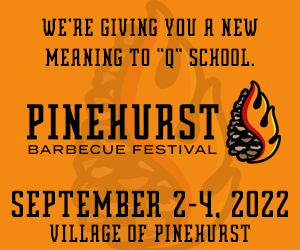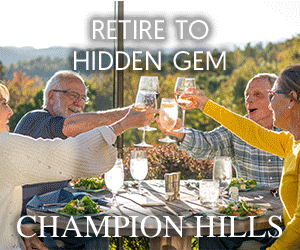 By DAVID DROSCHAK
By DAVID DROSCHAK
Certain victors and venues in sports are forever connected. There is Babe Ruth and The House That Ruth Built, Bobby Jones and Augusta National, and a legendary University of North Carolina hoops coach and the Dean Dome.
As the U.S. Open Championship approaches this June – for the third time in the last 15 years in the North Carolina Sandhills – our memories, our hearts, our emotions and our appreciation for the finer points of the game of golf can’t help but fixate on Payne Stewart and Pinehurst No. 2.
Stewart’s 18-foot putt on the 72nd hole in 1999 to beat Phil Mickelson is now firmly cemented in history, as is a bronze statue of the late golfer in his plus fours adjacent to the green outside of the steps of the resort clubhouse.
The fact that the life-sized statue of Stewart’s “One Moment in Time” celebratory fist pump is the most photographed image in Pinehurst shouldn’t be a surprise, said noted sports psychologist Dr. Richard Coop, who began working with Stewart in 1988.
“In some ways Payne was like every man, he showed his frustrations on the surface,” Coop said.
Coop saw Payne’s popularity and impact on golf firsthand when Stewart took Coop, swing teacher Chuck Cook and caddie Mike Hicks on a golfing trip to the British Isles after winning the 1991 U.S. Open.
“The parents got their kids out of school to come out to watch Payne play,” Coop said. “It was really interesting how much he connected with the Scots. In fact they recognized him without his plus fours on. Most people in the United States wouldn’t recognize him if he didn’t have what I called his ‘costume’ on. He wore a baseball cap and long slacks over there but the Scottish people knew him right off the bat.”
Coop once asked Stewart why he dressed so differently than the rest of the field.
“He told me he got tired of seeing everybody on the range looking the same, so he put together that outfit,” Coop said. “He also played the devil’s advocate a little bit just to see how you would handle it.”
In the late 1980s, Stewart flew to Chapel Hill to meet with the noted University of North Carolina sports psychologist in an attempt to gain a winning edge on his competition. At the time, Coop confessed to Stewart that he had asked numerous PGA Tour players about him … and he had some sobering news to share.
“They said you’re egotistical, brash and arrogant,” Coop recalled telling Stewart. “I looked at his face and he didn’t flinch. After we got through talking he asked to borrow my phone and he called his wife. She asked, ‘What did he say?’ Payne said he told me I was cocky and I was brash. She asked what he thought and he said, well, I probably am. That was neat. We got a lot of work done in one trip.”
Coop and Stewart became close friends over the next 11 years, sharing some of golf’s greatest highs (winning three major championships), some lows and a lot of fellowship, golf and travel in between. Their first PGA Tour event together Stewart lost in a playoff and the pair quickly meshed.
“When we met Payne was known as Avis, because he was No. 2 a lot. He couldn’t finish, so caddies give you names that sometimes stick,” Coop said.
Most casual golf fans didn’t realize Stewart suffered from a severe case of attention deficit hyperactivity disorder or ADHD, something that he and Coop worked on constantly.
“Payne was a deep thinker about golf,” said Coop, whose client list also included such golfing greats as Greg Norman, Ben Crenshaw and Nick Faldo. “Payne was much smarter than a lot of people. Payne was also very impulsive. One of the things about a lot of athletes with ADHD is they can hyper focus when the tension level is high. They can sit there and for hours perform in a major championship. I used to watch Payne’s eyes and he was hyper-focused in majors, but at the John Deere Classic he wouldn’t show up mentally. When the intensity level wasn’t high his mind would go on vacation.”
Coop would invent golfing challenges for Stewart out of items the talented pro didn’t consider a challenge.
“The worst shot I would see him hit was a plain vanilla chip, just something simple that we could hit very easily. It was too easy. He would have three or four different ways of playing it and he wouldn’t commit to a specific way. He would get caught in between. It’s almost like he was too talented for the script.”
That’s why Payne and Pinehurst fit so well, a course Donald Ross designed to challenge one’s spirit as much as a golfer’s physical ability.
“They were made for each other,” Coop said. “The creativity you had to have and the tough greens at No. 2 lent themselves to a person who had great visualization like Payne had. He put in a lot of hard work to prepare for those greens but his ability to visualize was so critical and his confidence in knowing where to play it.”
Battling a young Mickelson, who himself was fighting a case of the nerves wondering whether his wife was going to go into labor with the couple’s first child across the country, Stewart hit his approach shot to the final hole within 18 feet. As the championship was coming to a close, Stewart needed to sink his par putt for victory.
“It sure doesn’t feel like 15 years since I was there,” said USGA executive director Mike Davis. “I remember I was standing in front of our big leaderboard, not 25 yards from the green. When the ball was halfway to the hole it looked good, and just to see the entire place erupt was magical.”
Davis, and thousands more had walked up the fairway and were ringing the 18th green on the unseasonably cool and misty day, 10-, 12- 15-fans deep – while a packed grandstand leaned forward in their seats – as the drama unfolded. Once the putt dropped for the win, Stewart fashioned a memorable fist pump and Hicks leaped into the arms of his boss for one of golf’s all-time iconic photos.
“You usually don’t see a putt or a shot of that significance made on the 72nd hole of the championship,” Davis said. “Usually somebody has a two- or three-shot lead or somebody has a tap in for the win. When it was all said and done, when golf fans think of Payne Stewart, in terms of a competitive setting, what happened on that 72nd green is probably the most indelible memory that they’ll have. I don’t think we’ll forget that putt for a long time.”
Tom O’Toole, recently installed as USGA president, was a rules official that day. He remembers waiting at the bottom of the concrete steps in the cart barn area for Stewart, who he knew, both growing up in the amateur golfing circles of Missouri.
“I met him once in a parking lot in Kansas City in a near altercation between Payne and the player I was caddying for,” O’Toole said, laughing. “Just like the great Bob Jones, who started off with some temperament challenges, Payne was a brash young man but he really evolved into one of the great ambassadors of the game. He had a great spiritual journey … and when I met him at the bottom of the stairs at Pinehurst I didn’t realize at the time it was going to be as memorable as it turned out to be in light of his untimely death four months later. And he told me something earlier in the week, some wisdom – that I should treat my body as if I’ll live forever and treat my soul as if I’ll die tomorrow. He was a great champion.”
And great off the course to the people who meant the most in his life. For example, while most caddies on the PGA Tour pretty much earn their cash week-to-week, Stewart placed Hicks on salary and took him on golf trips away from the competitive game.
Hicks has various pieces of Stewart memorabilia he holds close to his heart. He moved from photo-to-photo recently, stopping at one as a wide grin moves across his face.
“This is the night after U.S. Open victory at Pinehurst and this is my house,” Hicks said. “Payne came and spent the night with me. We drank moonshine … you name it we drank it out of that trophy. We went to bed at 4 a.m.”
Just four months later, life for both would change forever. Stewart, 42, would die in a private plane crash in the prime of his golfing career and Hicks was without his best friend, who still remains on his refrigerator in the form of his favorite photo of Stewart in his plus-fours.
“I learned more from Payne about how to act on the course and the transformation that he took in his life, from being kind of hard to be around and hard to deal with at times, depending on which side of the bed he woke up on, to being at peace with himself and just becoming a wonderful person to be around 24/7,” Hicks said. “And the transformation he took with his game was remarkable.”
For the first time since 1955, the Bob Jones Award, the highest honor given by the USGA, didn’t occur at the organization’s annual banquet at Pinehurst Resort in February. Instead, Stewart will be honored posthumously on the Tuesday of the U.S. Open week in June.
“We started thinking about it and normally the award is experienced by 500 people at our banquet and that’s it,” Davis said. “For us to do this U.S. Open week, when you have thousands of people here, at the site it happened 15 years ago and to broadcast it worldwide, that’s going to be pretty special.
“What have we missed not having Payne around for 15 years? Well, Payne was a showman. He really was,” Davis said. “His peers really liked him, which says a lot about the person. He was somebody who was flamboyant, a lot of smiles; he was a little bit like Arnold (Palmer) on the golf course because he was always talking to fans, he didn’t have that laser focus like some of the players have. He was just great for the game.”
And in the end great for Pinehurst.
















